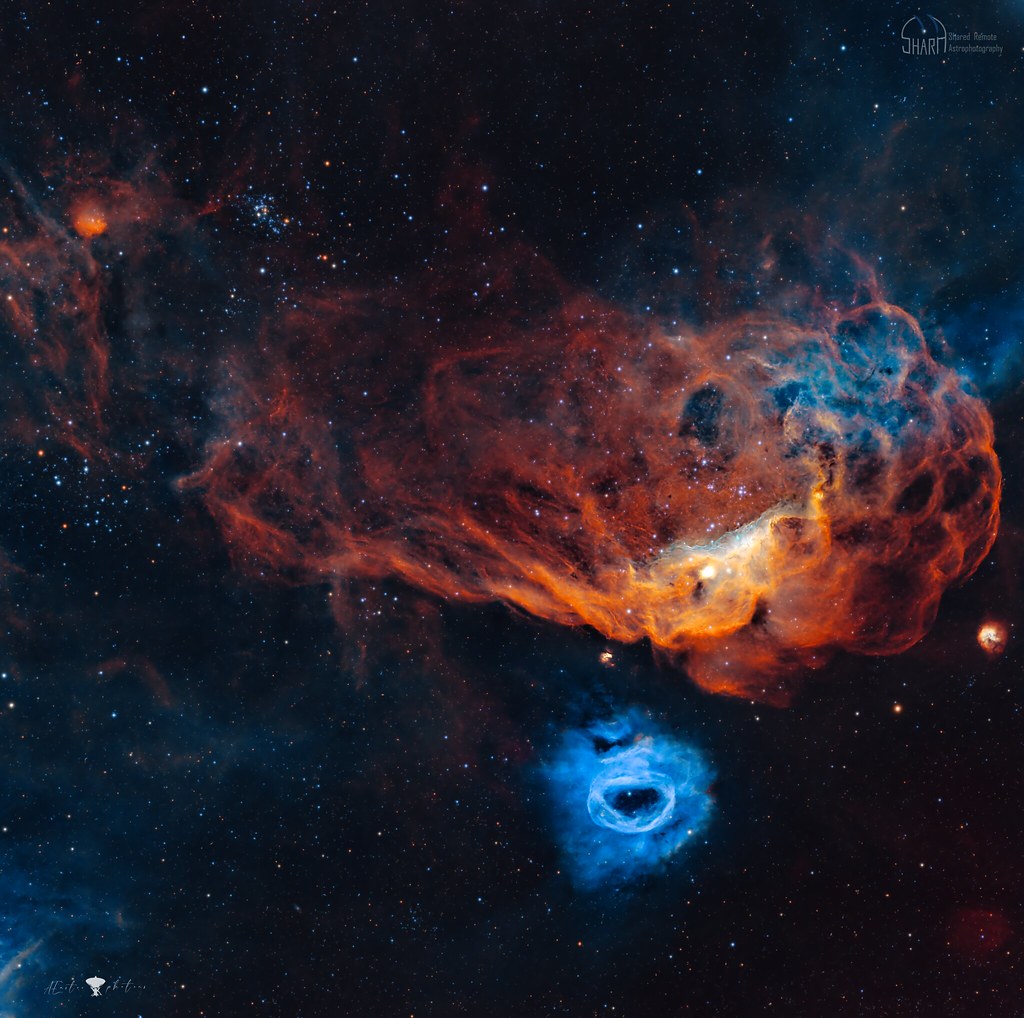Submissions: 2023 April
Submissions: 2023 April
__________________________________________________________________________________________________
Please post your images here.
Please see this thread before posting images; posting images demonstrates your agreement with
the possible uses for your image.
If hotlinking to an image, please ensure it is under 500K.
Hotlinks to images over 500K slow down the thread too much and will be disabled.
Thank you!
_________________________________________________________________________________________________
<- Previous submissions
Please post your images here.
Please see this thread before posting images; posting images demonstrates your agreement with
the possible uses for your image.
If hotlinking to an image, please ensure it is under 500K.
Hotlinks to images over 500K slow down the thread too much and will be disabled.
Thank you!
_________________________________________________________________________________________________
<- Previous submissions
Know the quiet place within your heart and touch the rainbow of possibility; be
alive to the gentle breeze of communication, and please stop being such a jerk. — Garrison Keillor
alive to the gentle breeze of communication, and please stop being such a jerk. — Garrison Keillor
Re: Submissions: 2023 April
Arp 84
Arp 84 is the combination of gravitationally-interacting galaxies NGC 5395 and NGC 5394. They are around 160 million light years from Earth in the constellation of Canes Venatici.
http://www.astrofotografie-hess.at/arp84.html
Telescope: ASA EQ1000 f7 - ASA 1 m equatorial telescope
Location: Vega Observatory - House of Nature Salzburg, Austria
Camera: FLI Microline 16803
Exposure time: 26x7min Luminance, 14x7min RGB Copyright: Rochus Hess
Website: www.astrofotografie-hess.at
Arp 84 is the combination of gravitationally-interacting galaxies NGC 5395 and NGC 5394. They are around 160 million light years from Earth in the constellation of Canes Venatici.
http://www.astrofotografie-hess.at/arp84.html
Telescope: ASA EQ1000 f7 - ASA 1 m equatorial telescope
Location: Vega Observatory - House of Nature Salzburg, Austria
Camera: FLI Microline 16803
Exposure time: 26x7min Luminance, 14x7min RGB Copyright: Rochus Hess
Website: www.astrofotografie-hess.at
-
Carballada
- Ensign
- Posts: 22
- Joined: Sat Mar 16, 2019 10:19 am
Re: Submissions: 2023 April

Wolf-Rayet 134 (WR 134) V1769 Cyg by Jose Carballada, on Flickr
WR 134 is a variable Wolf-Rayet star located around 6,000 light years away from Earth in the constellation of Cygnus, surrounded by a faint bubble nebula blown by the intense radiation and fast wind from the star.
It is five times the radius of the sun, but due to a temperature over 63,000 K it is 400,000 times as luminous as the Sun. (credits wikipedia)
Re: Submissions: 2023 April
THE EAGLEN EBULA (M16)
- Pillars of Creation
- Deepsky 750mm LRGB
- Constellation Serpense

The Eagle Nebula, or IC 4703, is about 7,000 light-years from the Sun. About 20 light-years across, the nebula contains pillars of dust up to 9.5 light-years long with new stars at their tops, hence the nickname Pillars of Creation. The opacity of the nebula is due to silicate and carbon particles. The mean age of the stars is around 800,000 years. Some stars are very young, with the youngest stars estimated to be 50,000 years old.
Actually, I wanted to add a few more hours this season, but the weather didn't help - therefore "only" a rework, where I incorporated many new insights into the image processing, which also justifies the rework in my opinion
Equipment & recording dates:
Skywatcher 150/750PDS Newtonian, Atik16200 mono with LRGB filter set from Astrodon, mount Skywatcher AZ-EQ6 GT Pro, PHD2 guiding.
Lights: L 64x 180s, R, G & B each 17x 180s, (flats, darks, bias calibrated, dithering every shot) - total exposure time about 5.5 hours. Recorded over several nights in February/March 2021
Recording software: NINA, PHD2, EQMod, Stellarium
Image editing:
mainly Pixinsight, plus Photoshop, Lightroom, GraXpert, BTX Blur Terminator, Noise Terminator, Star X Terminator
Weather:
Consistently clear nights with significant light pollution taken directly from the small town (balcony), on moonless nights at Bortle 7 skies.
#constellationserpense #Messier16 #pillarsofcration #universe #artofpixastro #astrophotography
- Pillars of Creation
- Deepsky 750mm LRGB
- Constellation Serpense

The Eagle Nebula, or IC 4703, is about 7,000 light-years from the Sun. About 20 light-years across, the nebula contains pillars of dust up to 9.5 light-years long with new stars at their tops, hence the nickname Pillars of Creation. The opacity of the nebula is due to silicate and carbon particles. The mean age of the stars is around 800,000 years. Some stars are very young, with the youngest stars estimated to be 50,000 years old.
Actually, I wanted to add a few more hours this season, but the weather didn't help - therefore "only" a rework, where I incorporated many new insights into the image processing, which also justifies the rework in my opinion
Equipment & recording dates:
Skywatcher 150/750PDS Newtonian, Atik16200 mono with LRGB filter set from Astrodon, mount Skywatcher AZ-EQ6 GT Pro, PHD2 guiding.
Lights: L 64x 180s, R, G & B each 17x 180s, (flats, darks, bias calibrated, dithering every shot) - total exposure time about 5.5 hours. Recorded over several nights in February/March 2021
Recording software: NINA, PHD2, EQMod, Stellarium
Image editing:
mainly Pixinsight, plus Photoshop, Lightroom, GraXpert, BTX Blur Terminator, Noise Terminator, Star X Terminator
Weather:
Consistently clear nights with significant light pollution taken directly from the small town (balcony), on moonless nights at Bortle 7 skies.
#constellationserpense #Messier16 #pillarsofcration #universe #artofpixastro #astrophotography
- the_astronomy_enthusiast
- Ensign
- Posts: 98
- Joined: Fri Apr 16, 2021 10:16 pm
- Contact:
Re: Submissions: 2023 April

The Spanish Dancer Galaxy by William Ostling, on Flickr
All details here: https://theastroenthusiast.com/the-span ... er-galaxy/
This is another image from telescope live, NGC 1566. This was a really tough image to stack, as there was a ton of uncalibrated dust motes in a lot of the frames, and there were a lot of dark artifacts on the brightest stars. Additionally, almost half of the frames had airplane trails that wouldn’t calibrate out. I ended up using the Adam Block method of selective rejection to try and remove a lot of the worst parts during stacking, and it seemed to work pretty well. Again, SPCC seems to be doing a better job of color calibration overall, however, I had to do some manual color balancing to remove the red cast.
An island universe of billions of stars, NGC 1566 lies about 60 million light-years away in the southern constellation Dorado. Popularly known as the Spanish Dancer galaxy, it’s seen face-on from our Milky Way perspective. A gorgeous grand design spiral, this galaxy’s two graceful spiral arms span over 100,000 light-years, traced by bright blue star clusters, pinkish starforming regions, and swirling cosmic dust lanes. NGC 1566’s flaring center makes the spiral one of the closest and brightest Seyfert galaxies. It likely houses a central supermassive black hole wreaking havoc on surrounding stars, gas, and dust. In this sharp southern galaxy portrait, the spiky stars lie well within the Milky Way.
Website: https://theastroenthusiast.com/
Instagram: https://www.instagram.com/the_astronomy_enthusiast/
Re: Submissions: 2023 April
Let me introduce you to one of the most beautiful gems in the southern hemisphere: The great and magnificent Eta Carina Complex.
The Eta Carinae Nebula is one of the largest regions of ionized hydrogen gas in our Galaxy. Expanded in 260 light years it has seven times the size of the Orion Nebula. The Nebula has produced the Star Eta Carina which is among of the most massive and luminous star in our Milky Way.
The color palette is obtained by combining O-III & H-Alpha filters which are specifically designed for nebula allowing 3nm bandwidth of light centered on a wavelength of 500nm and 656nm, blocking out all other light.
To go off the beaten track, I have decided to release a “starless version” which gives a better sense of what’s going on there.
Copyright: @ae_astrophotons & Heaven’s Mirror Observatory, Australia
Takahashi FSQ 106ED
O-III & H-Alpha filters
Data gathered between Feb & Mars 2023
Integration time 7H
The Eta Carinae Nebula is one of the largest regions of ionized hydrogen gas in our Galaxy. Expanded in 260 light years it has seven times the size of the Orion Nebula. The Nebula has produced the Star Eta Carina which is among of the most massive and luminous star in our Milky Way.
The color palette is obtained by combining O-III & H-Alpha filters which are specifically designed for nebula allowing 3nm bandwidth of light centered on a wavelength of 500nm and 656nm, blocking out all other light.
To go off the beaten track, I have decided to release a “starless version” which gives a better sense of what’s going on there.
Copyright: @ae_astrophotons & Heaven’s Mirror Observatory, Australia
Takahashi FSQ 106ED
O-III & H-Alpha filters
Data gathered between Feb & Mars 2023
Integration time 7H
Re: Submissions: 2023 April
THE EAGLEN EBULA (M16), ASSIMILATED ^^
- Pillars of Creation
- Deep sky 750mm LRGBSHO
- Constellation Serpense

The Eagle Nebula, or IC 4703, is about 7,000 light-years from the Sun. About 20 light-years across, the nebula contains pillars of dust up to 9.5 light-years long with new stars at their tops, hence the nickname Pillars of Creation. The opacity of the nebula is due to silicate and carbon particles. The mean age of the stars is around 800,000 years. Some stars are very young, with the youngest stars estimated to be 50,000 years old.
A variant of the coloring that is rarely used, it reminds me of the BORG ^^
Equipment & recording dates:
Skywatcher 150/750PDS Newtonian, Atik16200 mono with LRGB filter set from Astrodon, mount Skywatcher AZ-EQ6 GT Pro, PHD2 guiding.
Lights: L 64x 180s // R, G & B each 17x 180s // hA, SII & OIII each 8x 1200s (flats, darks, bias calibrated, dithering every shot) - total exposure time almost 14 hours. Recorded over several nights in February/March 2021
Recording software: NINA, PHD2, EQMod, Stellarium
Image editing:
mainly Pixinsight, plus Photoshop, Lightroom, GraXpert, BTX Blur Terminator, Noise Terminator, Star X Terminator
Weather:
Consistently clear nights with significant light pollution taken directly from the small town (balcony), on moonless nights at Bortle 7 skies.
- Pillars of Creation
- Deep sky 750mm LRGBSHO
- Constellation Serpense

The Eagle Nebula, or IC 4703, is about 7,000 light-years from the Sun. About 20 light-years across, the nebula contains pillars of dust up to 9.5 light-years long with new stars at their tops, hence the nickname Pillars of Creation. The opacity of the nebula is due to silicate and carbon particles. The mean age of the stars is around 800,000 years. Some stars are very young, with the youngest stars estimated to be 50,000 years old.
A variant of the coloring that is rarely used, it reminds me of the BORG ^^
Equipment & recording dates:
Skywatcher 150/750PDS Newtonian, Atik16200 mono with LRGB filter set from Astrodon, mount Skywatcher AZ-EQ6 GT Pro, PHD2 guiding.
Lights: L 64x 180s // R, G & B each 17x 180s // hA, SII & OIII each 8x 1200s (flats, darks, bias calibrated, dithering every shot) - total exposure time almost 14 hours. Recorded over several nights in February/March 2021
Recording software: NINA, PHD2, EQMod, Stellarium
Image editing:
mainly Pixinsight, plus Photoshop, Lightroom, GraXpert, BTX Blur Terminator, Noise Terminator, Star X Terminator
Weather:
Consistently clear nights with significant light pollution taken directly from the small town (balcony), on moonless nights at Bortle 7 skies.
Re: Submissions: 2023 April
Northern Milky Way over the Alien Head
 Northern Milky Way over the Alien Head by Ahmed Waddah, on Flickr
Northern Milky Way over the Alien Head by Ahmed Waddah, on Flickr
Image is a composite of a rock formation in the White Desert National Park in Farafra Oasis in Egypt. The rock was imaged just before sunset and the sky was imaged later that night behind and beyond the Structure. Image was taken in May of 2022 but an unfortunate due to data loss and recovery process last year I was just able to reorganize and process my data.
Sky:
Nikon Z6II - NikonZ14-24mm F2.8 S - Sky Watcher Star Adventurer 2i - 30 x 90" - ISO 2500 - f/2.8 @14mm
Foreground:
Nikon Z6II - NikonZ14-24mm F2.8 S - multiple HDR base exposure: ISO100 - f/8 - 1.6" @20mm
28 May, 2022
https://www.astrobin.com/xomxlp/
Facebook: https://www.facebook.com/waddah.photography
Astrobin: https://www.astrobin.com/users/WolfHeart/
IG: https://www.instagram.com/waddahphotography/
 Northern Milky Way over the Alien Head by Ahmed Waddah, on Flickr
Northern Milky Way over the Alien Head by Ahmed Waddah, on FlickrImage is a composite of a rock formation in the White Desert National Park in Farafra Oasis in Egypt. The rock was imaged just before sunset and the sky was imaged later that night behind and beyond the Structure. Image was taken in May of 2022 but an unfortunate due to data loss and recovery process last year I was just able to reorganize and process my data.
Sky:
Nikon Z6II - NikonZ14-24mm F2.8 S - Sky Watcher Star Adventurer 2i - 30 x 90" - ISO 2500 - f/2.8 @14mm
Foreground:
Nikon Z6II - NikonZ14-24mm F2.8 S - multiple HDR base exposure: ISO100 - f/8 - 1.6" @20mm
28 May, 2022
https://www.astrobin.com/xomxlp/
Facebook: https://www.facebook.com/waddah.photography
Astrobin: https://www.astrobin.com/users/WolfHeart/
IG: https://www.instagram.com/waddahphotography/
-
Meiying Lee
- Ensign
- Posts: 66
- Joined: Sun Aug 15, 2021 8:28 am
Re: Submissions: 2023 April
Like a Burning Sun
Twice a year we have the opportunities to see this interesting phenomenon from our balcony - the sun appears to be on fire! The building below the sun is an incinerator, and the "flames" are actually steam emissions from the incinerator. Normally, these emissions cannot be seen. However, when the morning sun rises directly above the incinerator, and the sunlight is not too strong, the steam's flow can be clearly seen due to refraction (and perhaps also scattering). The steam emission from the incinerator is strong, and it looks like the sun is burning with raging flames. It is truly an exciting spectacle, and I look forward to the sun being in this position every year!
Video link of the whole process: https://youtu.be/2509RcCEW8I
Equipment Details: Canon R7+600mm Lens
Post-processing Details:None
Location : Taipei, Taiwan
Time: April 3, 2023 at 5:58 am
Photographer : Meiying Lee (李美英)
Twice a year we have the opportunities to see this interesting phenomenon from our balcony - the sun appears to be on fire! The building below the sun is an incinerator, and the "flames" are actually steam emissions from the incinerator. Normally, these emissions cannot be seen. However, when the morning sun rises directly above the incinerator, and the sunlight is not too strong, the steam's flow can be clearly seen due to refraction (and perhaps also scattering). The steam emission from the incinerator is strong, and it looks like the sun is burning with raging flames. It is truly an exciting spectacle, and I look forward to the sun being in this position every year!
Video link of the whole process: https://youtu.be/2509RcCEW8I
Equipment Details: Canon R7+600mm Lens
Post-processing Details:None
Location : Taipei, Taiwan
Time: April 3, 2023 at 5:58 am
Photographer : Meiying Lee (李美英)
Re: Submissions: 2023 April
Cygnus Clouds Revisited
 Cygnus Clouds Revisited by Ahmed Waddah, on Flickr
Cygnus Clouds Revisited by Ahmed Waddah, on Flickr
Story:
Cygnus region is rich with excited ionized Hydrogen gas and its where the North America Nebula, Pelican Nebula, Butterfly Nebula and Crescent reside. So I decided to frame the most dense area in that region and use a fast lens like the Rokinon 135mm and a dual band filter to extract Ha and OIII and to recombine them in a mainly HOO color palette but with OIII coming from the Green and Blue channel. This image is a reprocess of the same data from 2022 that I had submitted once before!
Gear and acquisition details::
Date: 28/5/2022
102X180"
Nikon Z6II-Ha Modified
Rokinon 135mm @2.8
Fornax Lightrack II
IDAS-NBZ-Fast
Location: White Desert, Farafra
bortle:2
Image on Astrobin::
https://www.astrobin.com/m7suyg/B/
Facebook: https://www.facebook.com/waddah.photography
Astrobin: https://www.astrobin.com/users/WolfHeart/
IG: https://www.instagram.com/waddahphotography/
 Cygnus Clouds Revisited by Ahmed Waddah, on Flickr
Cygnus Clouds Revisited by Ahmed Waddah, on FlickrStory:
Cygnus region is rich with excited ionized Hydrogen gas and its where the North America Nebula, Pelican Nebula, Butterfly Nebula and Crescent reside. So I decided to frame the most dense area in that region and use a fast lens like the Rokinon 135mm and a dual band filter to extract Ha and OIII and to recombine them in a mainly HOO color palette but with OIII coming from the Green and Blue channel. This image is a reprocess of the same data from 2022 that I had submitted once before!
Gear and acquisition details::
Date: 28/5/2022
102X180"
Nikon Z6II-Ha Modified
Rokinon 135mm @2.8
Fornax Lightrack II
IDAS-NBZ-Fast
Location: White Desert, Farafra
bortle:2
Image on Astrobin::
https://www.astrobin.com/m7suyg/B/
Facebook: https://www.facebook.com/waddah.photography
Astrobin: https://www.astrobin.com/users/WolfHeart/
IG: https://www.instagram.com/waddahphotography/
Re: Submissions: 2023 April
Stock 23, Sh2-202, vdB 14 and vdB 15
http://www.distant-lights.at/vdb15-2016_09_27.htm
Copyright: Thomas Henne
http://www.distant-lights.at/vdb15-2016_09_27.htm
Copyright: Thomas Henne
-
Victor Lima
- Ensign
- Posts: 70
- Joined: Tue Apr 21, 2020 11:38 am
Re: Submissions: 2023 April
PANORAMA
Instagram: @victorlimaphoto
Devil's Throat - Iguazu Falls - Brazil
Registering the Milky Way Arch over the Devil's Throat, at Iguazu Falls/Brazil, was an incredible experience. In addition to the great adventure of walking through the Iguaçu National Park at night, home of jaguars and pumas, being close to the most impressive waterfalls in the world and feeling all the power and beauty of nature was an experience of a lifetime.
Immediately over the main waterfall we can see Saturn and the zodiacal light illuminating the horizon. The Small Magellanic Cloud appears just above the Devil's Throat, which is considered the heart of the Iguassu Falls.
Panoramic Shot
Canon EOS 6Da / Canon EF 16-35mm f/2.8L II USM
10x 16mm / f:2.8 / 10sec / ISO 6400
2021/03/14 05:04h
 Iguassu Falls & Universe by Victor Lima, no Flickr
Iguassu Falls & Universe by Victor Lima, no Flickr
Instagram: @victorlimaphoto
Devil's Throat - Iguazu Falls - Brazil
Registering the Milky Way Arch over the Devil's Throat, at Iguazu Falls/Brazil, was an incredible experience. In addition to the great adventure of walking through the Iguaçu National Park at night, home of jaguars and pumas, being close to the most impressive waterfalls in the world and feeling all the power and beauty of nature was an experience of a lifetime.
Immediately over the main waterfall we can see Saturn and the zodiacal light illuminating the horizon. The Small Magellanic Cloud appears just above the Devil's Throat, which is considered the heart of the Iguassu Falls.
Panoramic Shot
Canon EOS 6Da / Canon EF 16-35mm f/2.8L II USM
10x 16mm / f:2.8 / 10sec / ISO 6400
2021/03/14 05:04h
 Iguassu Falls & Universe by Victor Lima, no Flickr
Iguassu Falls & Universe by Victor Lima, no FlickrComets C/2022 E3 (ZTF) and C/2022 U2 (ATLAS) between Jan 06 and Jan 08
Comets C/2022 E3 (ZTF) and C/2022 U2 (ATLAS) near the galactic plane
On Feb 06, 2023 there was a close apparent approach between comets C/2022 E3 (ZTF) and C/2022 U2 (ATLAS). In that night ZTF also crossed the galactic plane. That unusual event was observed between 17:10 and 00:40 UTC.
Click on the preview for detailed information and full resolution pictures and videos.
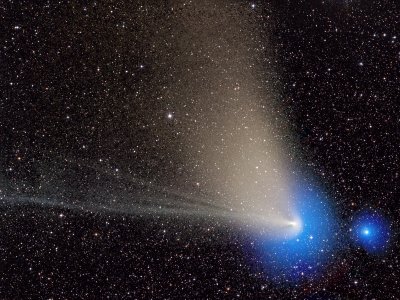
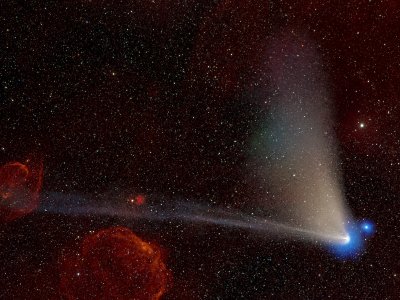

Comet C/2022 E3 (ZTF) on Feb 07, 2023
Comet C/2022 E3 (ZTF) was captured on Feb 07, 2023 in short time window between sunset and moonrise.
Click on the preview for detailed information and full resolution pictures.
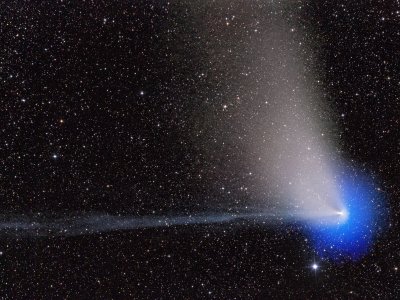

Comet C/2022 E3 (ZTF) near SH2-230 on Feb 08, 2023
On February 8 comet C/2022 E3 (ZTF) was close to the large nebula complex SH2-230 in constellation Auriga. The comet was observed between 17:25 and 20:00 UTC.
Click on the preview for detailed information and full resolution pictures and videos.

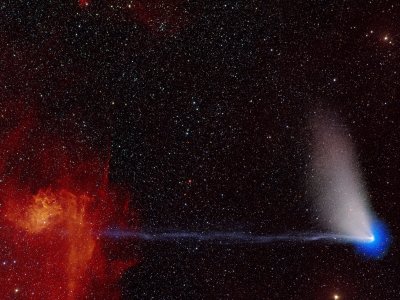

---
My Homepage
RSS news feed
On Feb 06, 2023 there was a close apparent approach between comets C/2022 E3 (ZTF) and C/2022 U2 (ATLAS). In that night ZTF also crossed the galactic plane. That unusual event was observed between 17:10 and 00:40 UTC.
Click on the preview for detailed information and full resolution pictures and videos.



Comet C/2022 E3 (ZTF) on Feb 07, 2023
Comet C/2022 E3 (ZTF) was captured on Feb 07, 2023 in short time window between sunset and moonrise.
Click on the preview for detailed information and full resolution pictures.


Comet C/2022 E3 (ZTF) near SH2-230 on Feb 08, 2023
On February 8 comet C/2022 E3 (ZTF) was close to the large nebula complex SH2-230 in constellation Auriga. The comet was observed between 17:25 and 20:00 UTC.
Click on the preview for detailed information and full resolution pictures and videos.



---
My Homepage
RSS news feed
-
chassaigne
- Ensign
- Posts: 20
- Joined: Sun Mar 19, 2023 3:22 pm
Re: Submissions: 2023 April
Messier 106 (also known asNGC 4258) is anintermediate spiral galaxy in the constellation Canes Venatici. It was discovered by Pierre Méchain in 1781. M106 is at a distance of about 22 to 25 million light-years away from Earth. M106 contains an active nucleus classified as aType 2 Seyfert, and the presence of a central supermassive black hole has been demonstrated from radio-wavelength observations of the rotation of adisk of molecular gas orbiting within the inner light-year around the black hole.[8]NGC 4217is a possible companion galaxy of Messier 106.
 M 106 Hargb 18h10mnVF3 by georges chassaigne, sur Flickr
M 106 Hargb 18h10mnVF3 by georges chassaigne, sur Flickr
Full image and data:
https://www.georges-chassaigne.fr/433170348/m-106
 M 106 Hargb 18h10mnVF3 by georges chassaigne, sur Flickr
M 106 Hargb 18h10mnVF3 by georges chassaigne, sur FlickrFull image and data:
https://www.georges-chassaigne.fr/433170348/m-106
-
barretosmed
- Science Officer
- Posts: 486
- Joined: Thu Oct 12, 2017 6:04 pm
Re: Submissions: 2023 April
MOON IN COLORS (MINERAL MOON)
MORE DETAILS
https://www.astrobin.com/full/zqq1n4/0/
The Moon is usually seen in subtle shades of gray or yellow.
The different colors are recognized as corresponding to real differences in the chemical composition of the lunar surface.
The blue tones reveal areas rich in ilmenite, which contain iron, titanium and oxygen, mainly titanium, while the orange and purple colors show regions relatively poor in titanium and iron. The white/gray tones refer to areas with greater sun exposure.
EQUIPMENT:
ZWO ASI 6200MC COLED
Spirit 150mm
Baader Lunar Filter
Date: 03/31/2023
Time: 7:30 pm
Location: Munhoz - MG - Brazil
PROCESSING AND CAPTURE: Software: Adobe Photoshop, SharpCap, AutoStakkert AutoStackert and Registax 6.
Copyright: Fernando Oliveira de Menezes
Email: Barretosmed@hotmail.com
(Organizing author of the book Astrofotografia Amadora no Brasil)
https://clubedeautores.com.br/livro/ast ... -no-brasil
MORE DETAILS
https://www.astrobin.com/full/zqq1n4/0/
The Moon is usually seen in subtle shades of gray or yellow.
The different colors are recognized as corresponding to real differences in the chemical composition of the lunar surface.
The blue tones reveal areas rich in ilmenite, which contain iron, titanium and oxygen, mainly titanium, while the orange and purple colors show regions relatively poor in titanium and iron. The white/gray tones refer to areas with greater sun exposure.
EQUIPMENT:
ZWO ASI 6200MC COLED
Spirit 150mm
Baader Lunar Filter
Date: 03/31/2023
Time: 7:30 pm
Location: Munhoz - MG - Brazil
PROCESSING AND CAPTURE: Software: Adobe Photoshop, SharpCap, AutoStakkert AutoStackert and Registax 6.
Copyright: Fernando Oliveira de Menezes
Email: Barretosmed@hotmail.com
(Organizing author of the book Astrofotografia Amadora no Brasil)
https://clubedeautores.com.br/livro/ast ... -no-brasil
Re: Submissions: 2023 April
Moon (m)
Total integration: 2-6 seconds (500-1500 x 4 milliseconds).
Cameras: QHY294M (11mp mono) CMOS cooled to -15 degrees C.
Telescope: Takahashi FC100DF Steinheil fluorite doublet apochromat refractor @ f/7.4.
Reducer: None.
Mount: Paramount MyT.
Filters: Orion SkyGlow Broadband L filter.
Software: TheSkyX Pro, SharpCap, PixInsight, Topaz Studio 2.
Inline image with reduced quality uploaded to the forum. Full resolution images of the entire series are available at https://www.astrobin.com/84ehrx/ and of the main image at http://ram.org/images/space/scope/1.7.4.7/moon.jpg
What can I say about our Moon that hasn't already been said in countless poems, songs, stories, movies? It is the only natural satellite of our planet, with a diametre about one quarter that of Earth and possessing one sixth of its surface gravity. It is the fifth largest satelite in our solar system and does not have any conditions suitable for life. The Moon orbits Earth at an average distance of 384,400 kilometres and is illuminated by our sun.
I normally stick to deep sky objects but during the last total lunar eclipse on November 11, 2022, I managed to capture 1500 exposures of the moon prior to the eclipse (in three batches of 500). Unfortunately it got cloudy so I couldn't image the eclipse itself. I registered and stacked the images using PixInsight and FFT registration and then processed it using Topaz Studio 2. Each of the 1500 frames was 4ms, with a gain of 0 on the QHY294M with the Takahashi FC100DF at F/7.4 (no reducer).
The first image is the processed version of the stacked 1500 exposures from all three sets; the second is the processed version of the stacked 500 exposures from the first set; and the third is the processed version of the very first frame only; and the final image is the unprocessed version of the stacked 1500 exposures.
As always, thanks for looking!
--Ram
Total integration: 2-6 seconds (500-1500 x 4 milliseconds).
Cameras: QHY294M (11mp mono) CMOS cooled to -15 degrees C.
Telescope: Takahashi FC100DF Steinheil fluorite doublet apochromat refractor @ f/7.4.
Reducer: None.
Mount: Paramount MyT.
Filters: Orion SkyGlow Broadband L filter.
Software: TheSkyX Pro, SharpCap, PixInsight, Topaz Studio 2.
Inline image with reduced quality uploaded to the forum. Full resolution images of the entire series are available at https://www.astrobin.com/84ehrx/ and of the main image at http://ram.org/images/space/scope/1.7.4.7/moon.jpg
What can I say about our Moon that hasn't already been said in countless poems, songs, stories, movies? It is the only natural satellite of our planet, with a diametre about one quarter that of Earth and possessing one sixth of its surface gravity. It is the fifth largest satelite in our solar system and does not have any conditions suitable for life. The Moon orbits Earth at an average distance of 384,400 kilometres and is illuminated by our sun.
I normally stick to deep sky objects but during the last total lunar eclipse on November 11, 2022, I managed to capture 1500 exposures of the moon prior to the eclipse (in three batches of 500). Unfortunately it got cloudy so I couldn't image the eclipse itself. I registered and stacked the images using PixInsight and FFT registration and then processed it using Topaz Studio 2. Each of the 1500 frames was 4ms, with a gain of 0 on the QHY294M with the Takahashi FC100DF at F/7.4 (no reducer).
The first image is the processed version of the stacked 1500 exposures from all three sets; the second is the processed version of the stacked 500 exposures from the first set; and the third is the processed version of the very first frame only; and the final image is the unprocessed version of the stacked 1500 exposures.
As always, thanks for looking!
--Ram
-
andreigusan
- Ensign
- Posts: 10
- Joined: Sun Jul 05, 2020 7:56 pm
Re: Submissions: 2023 April

Pinwheel Galaxy (M101) Galaxy
20 hours in HaLRGB
Telescope: TS-Photon 10" f/4 Newtonian @ 1016mm focal length with 1x GPU coma corrector
Camera: ASI294MM Pro Bin2
Filters: Astronomik Ha, RGB
Mount: iOptron CEM70-NUC
Guided with RedCat51 and ASI120MM mini
More details here: https://www.astrobin.com/8rempn/
https://cdn.astrobin.com/thumbs/PRcOiPf ... dlMP5Y.png
Last edited by bystander on Fri Apr 07, 2023 7:09 am, edited 1 time in total.
Reason: Please, no hot links to images > 500 kb. Substituted smaller image.
Reason: Please, no hot links to images > 500 kb. Substituted smaller image.
Re: Submissions: 2023 April
ShaRA team's member
You may ask, what does ShaRA stand for? It's a new open project called "Shared Remote Astrophotography» and is based on crowd or group funding for buying imaging time on large telescopes around the world. Since this beautiful hoppy is somehow expensive (it's an understatement ), a great idea emerged and allowed non-occupational astrophotographers (like many of us) to work together and put their hands on top-notch instruments like the one used as part as this project (see details below).
This picture features the Cosmic Reef whose data has been gathered thanks to a great collaboration of a dozen of astrophotographers from different countries. With regards to this project, ShaRA team agreed upon renting a 1-meter large telescope located in Rio Hurtado, Chile. It took to the team several nights, in late 2022 to gather enough data so that we could produce image like the one that I have processed and submitting on behalf of the team.
As you may have noticed, this image is really close in terms of color and rendering to the Hubble version published in 2020 (see below image): https://hubblesite.org/contents/media/i ... 4646-Image
Processing this image was very insightful and challenging. Very complicated to make it sharp and at the same time keeping artifacts and noise at bay. However, it's comforting to see that even Hubble's image isn't that sharp . Therefore, I may consider the job as "done".
. Therefore, I may consider the job as "done".
Kudos to the whole ShaRA team !
Clear Skies
Aygen
Link:https://www.astrobin.com/7tsga8/?utm_so ... ser=114539
You may ask, what does ShaRA stand for? It's a new open project called "Shared Remote Astrophotography» and is based on crowd or group funding for buying imaging time on large telescopes around the world. Since this beautiful hoppy is somehow expensive (it's an understatement ), a great idea emerged and allowed non-occupational astrophotographers (like many of us) to work together and put their hands on top-notch instruments like the one used as part as this project (see details below).
This picture features the Cosmic Reef whose data has been gathered thanks to a great collaboration of a dozen of astrophotographers from different countries. With regards to this project, ShaRA team agreed upon renting a 1-meter large telescope located in Rio Hurtado, Chile. It took to the team several nights, in late 2022 to gather enough data so that we could produce image like the one that I have processed and submitting on behalf of the team.
As you may have noticed, this image is really close in terms of color and rendering to the Hubble version published in 2020 (see below image): https://hubblesite.org/contents/media/i ... 4646-Image
Processing this image was very insightful and challenging. Very complicated to make it sharp and at the same time keeping artifacts and noise at bay. However, it's comforting to see that even Hubble's image isn't that sharp
Kudos to the whole ShaRA team !
Clear Skies
Aygen
Link:https://www.astrobin.com/7tsga8/?utm_so ... ser=114539
-
photonsfromspace
- Asternaut
- Posts: 3
- Joined: Thu Feb 09, 2023 7:37 pm
Re: Submissions: 2023 April
Discovered by Charles Messier in 1773, M51 is located 31 million light-years from Earth in the constellation Canes Venatici. It has an apparent magnitude of 8.4 and can be spotted with a small telescope most easily during May. The Whirlpool galaxy’s beautiful face-on view and closeness to Earth allow astronomers to study a classic spiral galaxy’s structure and star-forming processes. Some astronomers think that the Whirlpool’s arms are particularly prominent because of the effects of a close encounter with NGC 5195, the small, yellowish galaxy at the outermost tip of one of the arms. The smaller galaxy seems to be tugging on the arms, which trigger new star formation.
395 - 90 sec Lum
153 - 180 sec RGB
14 hours integration
Bortle 5
ZWO 294MM Pro Gain 120
EdgeHD 8" .7 reducer
Celestron OAG
ZWO 174mm guide camera
Moonlite CHL 2.5 focuser
QHY CFW3 Filter Wheel
Astronomik Deep Sky Filter
Pixinsight / Lightroom
395 - 90 sec Lum
153 - 180 sec RGB
14 hours integration
Bortle 5
ZWO 294MM Pro Gain 120
EdgeHD 8" .7 reducer
Celestron OAG
ZWO 174mm guide camera
Moonlite CHL 2.5 focuser
QHY CFW3 Filter Wheel
Astronomik Deep Sky Filter
Pixinsight / Lightroom
-
salvatorecerruto
- Ensign
- Posts: 23
- Joined: Thu Aug 22, 2019 2:28 pm
Re: Submissions: 2023 April
 April full moon by Salvatore Cerruto, su Flickr
April full moon by Salvatore Cerruto, su FlickrTonight's full moon highlights the frame of clouds that has formed around it with its light. A frame that is stirred by the wind, which for a few moments has made our beloved moon the absolute protagonist of tonight's sky.
Nikon D800 + Tamron 100-400
Sky and moon halo: 195mm, f/5.3, ISO-1600, 1/15 s
Moon details: 195mm, f/5.3, ISO-1000, 1/800 s
Per aspera ad astra
Salvatore
-
diegopisano
- Asternaut
- Posts: 2
- Joined: Fri Apr 07, 2023 7:39 am
Re: Submissions: 2023 April
Orion wide field mosaic:
45 Hours in HSO and RGB
Acquired with various scopes:

Orion Wide Field Mosaic by diego pisano, su Flickr
IG: https://www.instagram.com/_diegopisano_/
Flickr: https://flickr.com/photos/151824007@N06/
https://live.staticflickr.com/65535/527 ... 6a9d_k.jpg
45 Hours in HSO and RGB
Acquired with various scopes:
- Takahashi FSQ-106ED
- ASA 500N
- Planeweave CDK24
- El Sauce Observatory, Chile
- IC Astronomy Observatory, Spain
- Heaven's Mirror Observatory, Australia

Orion Wide Field Mosaic by diego pisano, su Flickr
IG: https://www.instagram.com/_diegopisano_/
Flickr: https://flickr.com/photos/151824007@N06/
https://live.staticflickr.com/65535/527 ... 6a9d_k.jpg
Last edited by bystander on Fri Apr 07, 2023 1:28 pm, edited 1 time in total.
Reason: Please, no hot links to images > 500 kb. Substituted smaller image.
Reason: Please, no hot links to images > 500 kb. Substituted smaller image.
-
ExplorerEGYWO
- Ensign
- Posts: 28
- Joined: Mon Jul 19, 2021 6:40 pm
Re: Submissions: 2023 April
 Ramadan full moon by Wael Omar, on Flickr
Ramadan full moon by Wael Omar, on Flickr Over Khofo by Wael Omar, on Flickr
Over Khofo by Wael Omar, on Flickr Over Khofo 2 by Wael Omar, on Flickr
Over Khofo 2 by Wael Omar, on Flickr Over khofo and Khafraa by Wael Omar, on Flickr
Over khofo and Khafraa by Wael Omar, on FlickrRamadan Full moon over the Pyramids.
In Muslim and Arab world now there is Ramadan month, Ramadan is the ninth month in the Islamic calendar which is based on a 12-month lunar year of approximately 354 days. Ramadan is considered one of the holiest months of the year for Muslims. In Ramadan, Muslims commemorate the revelation of the Qur’an, and fast from food and drink during the sunlit hours as a means of drawing closer to God and cultivating self-control, gratitude, and compassion for those less fortunate. Because the lunar year is 11 days shorter than the solar year, each lunar month moves 11 days earlier each year. That’s why Ramadan full moon today coincide with Pink Moon. In North America its called Pink moon as April’s full Moon often corresponded with the early springtime blooms of a certain wildflower native to eastern North America: "Phlox subulata" , which also went by the name “moss pink.”
These images were really challenging for me as I was fasting, I didn’t drink or eat for 16 hours and I climbed high building 70 Meters to have a clear view for the Pyramids . I was away by several kilometers from the pyramids ,the air was little dusty and the pyramids was completely dark. I tried to get as much details for the scene as I possible then get down the building to drink and eat
Settings :
Wide image : One shot 3.5 seconds ,F 9 , ISO 800 @ 55 mm.
For close shoots: 0.5 second, ISO 2500 , F5.6 @450 mm
All images here are one shot, No Blending No composite.
Date and Time :
06 April 2023 , 18:48 to 19:01 pm.
Location : Giza ,EGYPT.
Credit: Wael Omar WO /https://www.instagram.com/waelomar_astrophotography/
Re: Submissions: 2023 April
NGC 2841 - Massive nearby spiral galaxy toward the constellation of Ursa Major.
Copyright: Velimir Popov, Emil Ivanov
With a diameter of about 150 000 light-years, NGC 2841 is larger than our own Milky Way galaxy. NGC 2841lies about 46 million light-years away and the disk of the galaxy shows no evidence for grand design structure (Leroy et al. 2008), although near-infrared observations do show some long dark spiral features in its interior (Block et al. 1996). NGC 2841 is an early-type Sc spiral galaxy (Bagetakos et al., 2011) and It is notable for being the archetype for the flocculent class of spiral galaxies.
Higher resolution: NGC 2841
The next image is a crop version:
The frames were taken with:
Telescope: 16" RC Astrograph at F/6.4
Camera: MORAVIAN C4-16000 CMOS;
Filter RVB- photometric (Bessel) and L (clear) 22x2min each, total 176 min, bin1.
http://www.irida-observatory.org
Copyright: Velimir Popov, Emil Ivanov
With a diameter of about 150 000 light-years, NGC 2841 is larger than our own Milky Way galaxy. NGC 2841lies about 46 million light-years away and the disk of the galaxy shows no evidence for grand design structure (Leroy et al. 2008), although near-infrared observations do show some long dark spiral features in its interior (Block et al. 1996). NGC 2841 is an early-type Sc spiral galaxy (Bagetakos et al., 2011) and It is notable for being the archetype for the flocculent class of spiral galaxies.
Higher resolution: NGC 2841
The next image is a crop version:
The frames were taken with:
Telescope: 16" RC Astrograph at F/6.4
Camera: MORAVIAN C4-16000 CMOS;
Filter RVB- photometric (Bessel) and L (clear) 22x2min each, total 176 min, bin1.
http://www.irida-observatory.org
Re: Submissions: 2023 April
Hi,
Messier 61 - a deep view with Ha added
Full resolution 6100X4300 Pixels...:
https://pbase.com/tango33/image/173483027
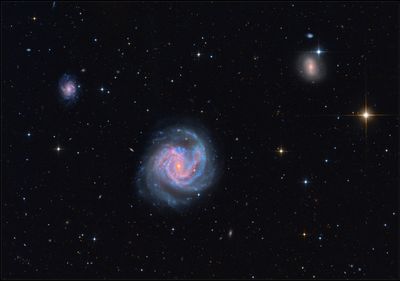
https://a4.pbase.com/o12/85/890385/1/17 ... small2.jpg
The fighting dragons starless mosaic:
Full resolution 11670X9600 pixels:
https://pbase.com/tango33/image/173483050
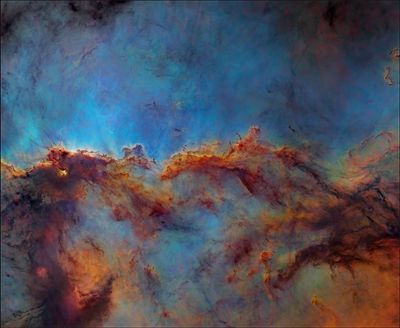
https://a4.pbase.com/o12/85/890385/1/17 ... color2.jpg
Thanks for looking!
Kfir Simon
Messier 61 - a deep view with Ha added
Full resolution 6100X4300 Pixels...:
https://pbase.com/tango33/image/173483027
https://a4.pbase.com/o12/85/890385/1/17 ... small2.jpg
The fighting dragons starless mosaic:
Full resolution 11670X9600 pixels:
https://pbase.com/tango33/image/173483050
https://a4.pbase.com/o12/85/890385/1/17 ... color2.jpg
Thanks for looking!
Kfir Simon
Last edited by bystander on Sat Apr 08, 2023 9:26 am, edited 1 time in total.
Reason: Please, no hot links to images > 500 kb. Substituted smaller images.
Reason: Please, no hot links to images > 500 kb. Substituted smaller images.
Re: Submissions: 2023 April
4500 years of Human History
https://tripswithrosie.com
Copyright: Rositsa Dimitrova, @tripswithrosie Location: Great Pyramid of Giza, Egypt
Date: 06.04.2023
Story:
After over a year of planning, I finally got my dream shot with the Great Pyramid of Giza - actually much better than what I expected. As I was shooting the oldest pyramid in the world (dating about 2500 BC), suddenly a plane passed by! The chances were probably rarer than one in a million and I was ecstatic I could capture 4500 years of human history in just 1 frame.
https://tripswithrosie.com
Copyright: Rositsa Dimitrova, @tripswithrosie Location: Great Pyramid of Giza, Egypt
Date: 06.04.2023
Story:
After over a year of planning, I finally got my dream shot with the Great Pyramid of Giza - actually much better than what I expected. As I was shooting the oldest pyramid in the world (dating about 2500 BC), suddenly a plane passed by! The chances were probably rarer than one in a million and I was ecstatic I could capture 4500 years of human history in just 1 frame.


